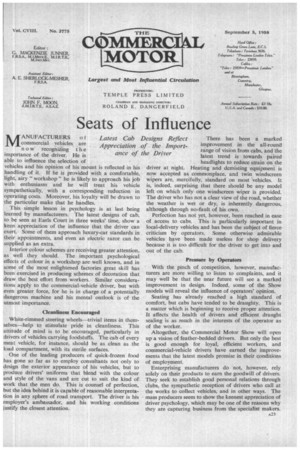Seats of Influence
Page 25

If you've noticed an error in this article please click here to report it so we can fix it.
MANUFACTURERS o t commercial vehicles are a o w recognizing t h e importance of the driver. He is able to influence the selection of vehicles and his opinion of his mount is reflected in his handling of it. If he is provided with a comfortable, light, airy " workshop " he is likely to approach his job with enthusiasm and he will treat his vehicle sympathetically, with a corresponding reduction in operating costs. Moreover, his loyalty will be drawn to the particular make that he handles.
This simple lesson in psychology is at last being learned by manufacturers. The latest designs of cab, to be seen at Earls Court in three weeks' time, show a keen appreciation of the influence that the driver can exert. Some of them approach luxury-car standards in their appointments, and even an electric razor can be supplied as an extra.
Interior colour schemes are receiving greater attention, as well they should. The important psychological effects of colour in a workshop are well known, and in some of the most enlightened factories great skill has been exercised in producing schemes of decoration that draw the best effort from workers. Similar considerations apply to the commercial-vehicle driver, but with even greater force, for he is in charge of a potentially dangerous machine and his mental outlook is of the utmost importance.
Cleanliness Encouraged White-rimmed steering wheels—trivial items in themselves—help to stimulate pride in cleanliness. This attitude of mind is to be encouraged, particularly in drivers of vehicles carrying foodstuffs. The cab of every meat vehicle, for instance, should be as clean as the load compartment, with its sterile surfaces.
One of the leading producers of quick-frozen food has gone so far as to employ consultants not only to design the exterior appearance of his vehicles, but to produce drivers' uniforms that blend with the colour and style of the vans and are cut to suit the kind of work that the men do. This is counsel of perfection, but the idea behind it is capable of reasonable interpretation in any sphere of road transport. The driver is his employer's ambassador, and his working conditions justify the closest attention. There has been a marked improvement in the all-round range of vision from cabs, and the latest trend is towards paired headlights to reduce strain on the driver at night. Heating and demisting equipment is now accepted as commonplace, and twin windscreen wipers are, mercifully, standard on most vehicles. Lt is, indeed, surprising that there should be any model left on which only one windscreen wiper is provided. The driver who has not a clear view of the road, whether the weather is wet or dry, is inherently dangerous, although through no fault of his own.
Perfection has not yet, however, been reached in ease of access to cabs. This is pafticularly important in local-delivery vehicles and has been the subject of fierce criticism by operators. Some otherwise admirable vehicles have been made useless for shop delivery because it is too difficult for the driver to get into and out of the cab.
Pressure by Operators With the pinch of competition, however, manufacturers are more willing to listen to complaints, and it may well be that the near future will see a marked improvement in design. Indeed, some of the Show models will reveal the influence of operators' opinion.
Seating has already reached a high standard of comfort, but cabs have tended to be draughty. This is a matter which is beginning to receive proper attention. It affects the health of drivers and efficient draught sealing is as much in the interests of the operator as of the worker.
Altogether, the Commercial Motor Show will open up a vision of feather-bedded drivers. But only the best is good enough for loyal, efficient workers, and commercial-vehicle drivers have earned the improvements that the latest models promise in their conditions of employment.
Enterprising manufacturers do not, however, rely solely on their products to earn the goodwill of drivers. They seek to establish good personal relations through clubs, the sympathetic reception of drivers who call at the works to collect vehicles, and in other ways. The mass producers seem to show the keenest appreciation of driver psychology, which may be one of the reasons why they are capturing business from the specialist makers.




































































































